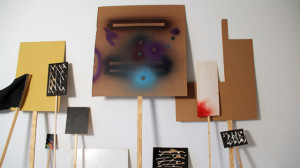It was a gloriously warm day, the kind usually spent in Dolores Park or out at the beach with friends and a playful dog. By the time I arrived at 248 Utah Street in the late afternoon, the inaugural Potrero Art Walk was in full swing. White wine and water flowed heavily as visitors moved between the new digs for Catharine Clark and Brian Gross — both of which moved into the building a year after Todd Hosfelt Gallery successfully transitioned into the space — or to visit Jack Fischer or George Lawson nearby at 311 Potrero. The overall mood was joyous, giddy almost, with the recognition that the arrival of these galleries in the neighborhood represents a page turning in San Francisco’s cultural history book.
Excitement was also stirred by the work on view. Catharine Clark tapped Anthony Discenza, one of many notable artists on her roster, to organize the new space’s inaugural exhibition. The artist has stated that this adventure may be his last, but I’m hoping that he nurtures his nascent curatorial chops. As This Is the Sound of Someone Losing the Plot demonstrates, Discenza capably balances content and concept. The work of nine alumni and faculty members at California College of the Arts (CCA) was selected to address notions of slippage or (mis)translation between working and understanding.

Arash Fayez and Maya Pasternak at Catharine Clark Gallery
Of the numerous pieces displayed, those that stand out include Horizon (2011), in which Arash Fayez and Maya Pasternak attempt to communicate with one another in Farsi and Hebrew, their respective native languages, and Stephanie Syjuco’s The Precariat (2013). The two monitors on which Fayez’s video feed plays are positioned too close to one another, which makes seeing or hearing what the actors say nearly impossible, and drives home the metaphoric difficulty inherent to communication. Fayez and Pasternak seem to speak beyond, not with one other, each laboring to remain civil when frustration sets in. It’s a powerful statement about relationships, be that between countries or individuals, and the centrality of clear communication.

Stephanie Syjuco at Catharine Clark Gallery
Syjuco’s installation, created in part with material that accumulated as the gallery prepared to open in its new space, notes the often fitful, failure-laden evolution of an artist’s work. This strong group exhibition, rounded out by Kate Bonner, Lauren Marsden, Bruno Fazzolari, Josh Greene, Patricia Esquivias, and collaborators Gareth Spor and Piero Passacantando celebrates the contributions made by CCA graduates and staff and further strengthens Clark’s ties to the neighborhood.





